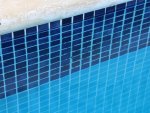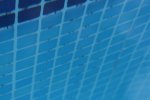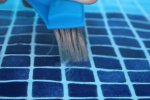Hi everyone, and thanks for a great and informative site.
I have a question and would like to share my pool story at the same time:
We took over the maintenance of the pool that came with our recently acquired house in October, after going through 3 cycles of green algae, shock+algecide and then green hair for our blonde children
The explanation from the pool maintainer didn't seem right, so I found this great site and thought it sounded like overstabilization, so purchased a Taylor test kit and found the cyanuric acid was way off the scale (somewhere between 200-400ppm), and a pH well below 7 (Trichlor tablets heavily in use)
The mosaic tile grout was also soft, and first time after using one of those big Whale brushes the pool became so cloudy you couldn't see your own hand 2 feet in front of you and the cartridge filter clogged up.
So we decided to drain the pool completely and have the tiles regrouted - the contractor did a pretty poor job at removing the old tile grout at first and had to replace nearly 1000 mosaics that got scratched from when the grout was removed, but eventually we got to the point where we could refill, and once the grout had cured and the water was in, the grout was hard and proper.
I took on the responsibility of adding the chemicals, and did the aeration trick and borated the pool, and the water looks great and is quite low maintenance. We've recently added an AutoPilot SWG to get away from Tri-chlor tablets, and are all enjoying the pool and it looks great.
The only minor issue is some stains on parts of the grout which came about when we first chlorinated the pool (I suspect oxidation of the iron in the tap water used for filling)
However, now nearly 2 months after refilling the pool, the tile grout is going soft to the point where you can etch it with a finger nail, and a micro cloud of grout can be seen in the water - saturation index wise I thought I had kept things on the good side, perhaps except for the 7-10 days I was aerating to lower the TA in preparation for the Borate/Borax addition).
So I am not sure if the tile grout used was some inferior product, or if it is purely an issue based on the saturation index of the pool. My question is whether I should add more calcium to the pool (Say bring CH to 325-350) or if it is already a lost cause and regrouting will be necessary at some point.
Pool details:
11500 Gallons / 44Cubic Meters
Taylors test kit
pH: 7.6 (Fluctuates between 7.4 and 7.6 adding muriatic acid as necessary)
FC: 5.5
CC: 0
CH: 275
TA: 60
CYA: 50
Borate: ~50ppm (Calculated, not measured)
Temperature: 27c (From AutoPilot)
Salt Level: 3000 (From AutoPilot)
Best regards and Happy New Year,
Kim
I have a question and would like to share my pool story at the same time:
We took over the maintenance of the pool that came with our recently acquired house in October, after going through 3 cycles of green algae, shock+algecide and then green hair for our blonde children
The explanation from the pool maintainer didn't seem right, so I found this great site and thought it sounded like overstabilization, so purchased a Taylor test kit and found the cyanuric acid was way off the scale (somewhere between 200-400ppm), and a pH well below 7 (Trichlor tablets heavily in use)
The mosaic tile grout was also soft, and first time after using one of those big Whale brushes the pool became so cloudy you couldn't see your own hand 2 feet in front of you and the cartridge filter clogged up.
So we decided to drain the pool completely and have the tiles regrouted - the contractor did a pretty poor job at removing the old tile grout at first and had to replace nearly 1000 mosaics that got scratched from when the grout was removed, but eventually we got to the point where we could refill, and once the grout had cured and the water was in, the grout was hard and proper.
I took on the responsibility of adding the chemicals, and did the aeration trick and borated the pool, and the water looks great and is quite low maintenance. We've recently added an AutoPilot SWG to get away from Tri-chlor tablets, and are all enjoying the pool and it looks great.
The only minor issue is some stains on parts of the grout which came about when we first chlorinated the pool (I suspect oxidation of the iron in the tap water used for filling)
However, now nearly 2 months after refilling the pool, the tile grout is going soft to the point where you can etch it with a finger nail, and a micro cloud of grout can be seen in the water - saturation index wise I thought I had kept things on the good side, perhaps except for the 7-10 days I was aerating to lower the TA in preparation for the Borate/Borax addition).
So I am not sure if the tile grout used was some inferior product, or if it is purely an issue based on the saturation index of the pool. My question is whether I should add more calcium to the pool (Say bring CH to 325-350) or if it is already a lost cause and regrouting will be necessary at some point.
Pool details:
11500 Gallons / 44Cubic Meters
Taylors test kit
pH: 7.6 (Fluctuates between 7.4 and 7.6 adding muriatic acid as necessary)
FC: 5.5
CC: 0
CH: 275
TA: 60
CYA: 50
Borate: ~50ppm (Calculated, not measured)
Temperature: 27c (From AutoPilot)
Salt Level: 3000 (From AutoPilot)
Best regards and Happy New Year,
Kim




